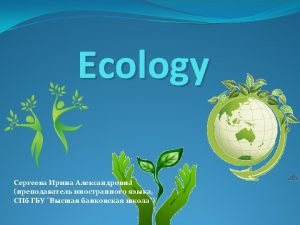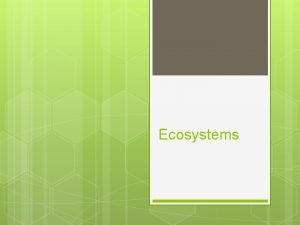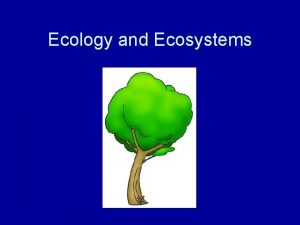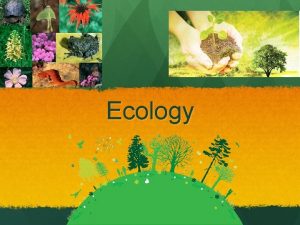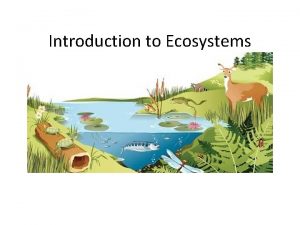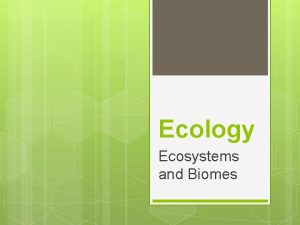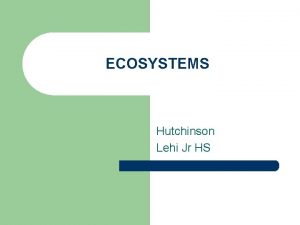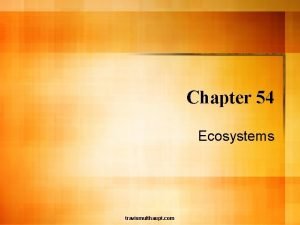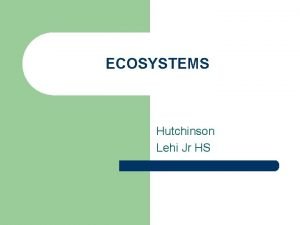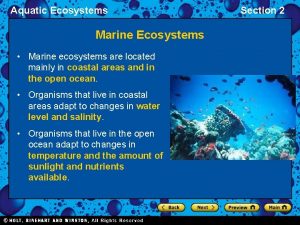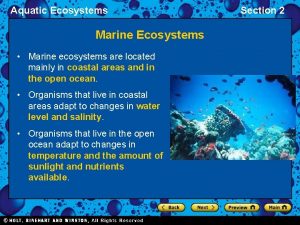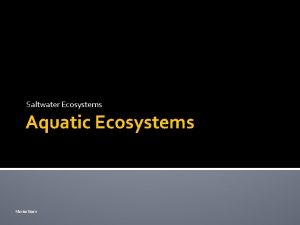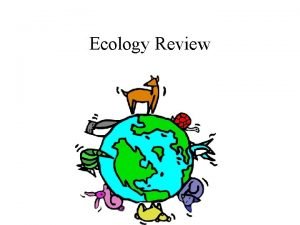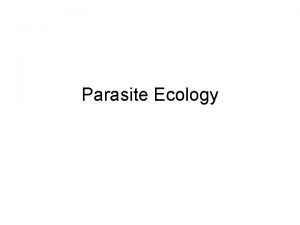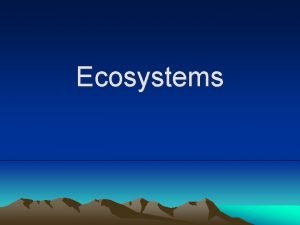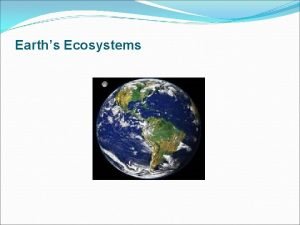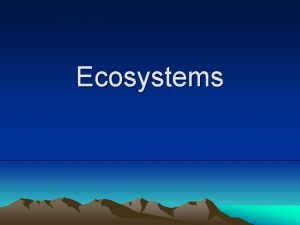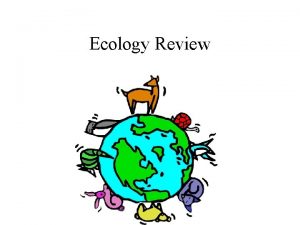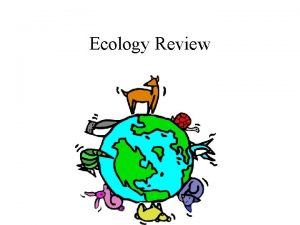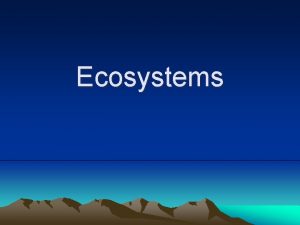Ecosystems What is Ecology Ecology is the study
























- Slides: 24

Ecosystems

What is Ecology? • Ecology is the study of relationships between living things and their environment.

What is an ecosystem? • Ecosystem is a system of living things that interact with each other and with the physical world. • A Biome is a collection of related ecosystems.

Main Ecosystems: • • Desert Rainforest Ocean Salt Marshes • Estuaries • Grassland • Temperate Forrest

Oceans • • • Water: Submerged Temperature: Varies Soil: None Plants: Aquatic Plants (seaweed) Animals: Fish, Shelled fish, invertebrates (animals with out backbones), select mammals.

Oceans

Rainforest • • Water: Very wet Temperature: Very warm Soil: Poor, thin soil Plants: Many plants (trees, flowers, shrubs, etc. ) • Animals: Many animals (birds, mammals, reptiles, insects, etc. )

Rainforests

Grassland • Water: Wet season, dry season • Temperature: Warm to hot (but often has a cold season) • Soil: Fertile soil • Plants: Grasses (few or no trees) • Animals: Many mammals, birds, insects, arachnids, etc.

Temperate Forest • Water: Adequate • Temperature: Cool season and warm season • Soil: Fertile soil • Plants: Deciduous trees, shrubs, ground cover • Animals: Many mammals, birds, reptiles, insects, arachnids, etc.

Temperate Forest

Desert • Water: Dry (almost none) • Temperature: Hot or Cold (one or the other) • Soil: Poor (sandy) • Plants: Sparse - succulents (like cactus), sage brush • Animals: Sparse - insects, arachnids, reptiles and birds (often nocturnal)

Desert

Ponds • • Water: freshwater Temperature: Varies Soil: Varies Plants: Floating plants (water lilies, pondweed, duckweed, phytoplankton, • Animals: Fish, Zooplankton, sometimes turtles or ducks

Ponds

Salt Marshes/Estuaries • • Water: mix of freshwater and saltwater Temperature: Varies Soil: Varies Plants: diversity of grasses, shrubs and flowering plants (salt tolerant plants that adapt to the tide) • Animals: Mollusks like snails, oysters and conch as well as crustaceans like crabs, shrimp and hermits meander back and forth between marsh water and land. Aquatic birds and alligators.

Salt Marshes

What type of ecosystem is most prominent in the world? Grassland Taiga Tundra Temperate Forrest Desert White: Ocean

However… • An ecosystem can be as large as the Sahara Desert, or as small as a puddle!!! • Ecosystems are more than just the organisms they contain. Geography, weather, climate and geologic factors also influence the interactions within an ecosystem.

Abiotic Factors nonliving physical factors of an environment. Abiotic Factors include amount of water and oxygen, temperature, amount of sunlight and water pressure.

Now You Try! Can you list some more examples of Abiotic Factors?

Biotic Factors Are the living, physical factors of an environment. Examples of Biotic Factors are parasitism, disease and predation.

Balance n Ecosystems will fail if they do not remain in balance. n No community can carry more organisms than its food, water and shelter can accommodate.

How do they stay balanced? n To succeed in an ecosystem, plants and animals have special structures and behaviors called adaptations. n Ex) Chameleon Polar Bear Can you think of more examples of adaptation?
 Phosphorus cycle pearson education
Phosphorus cycle pearson education Chapter 55 ecosystems and restoration ecology
Chapter 55 ecosystems and restoration ecology Chapter 5 how ecosystems work study guide
Chapter 5 how ecosystems work study guide Ecology is the study that helps to preserve
Ecology is the study that helps to preserve Ecology study guide answers
Ecology study guide answers Chapter 3 section 1: community ecology answer key
Chapter 3 section 1: community ecology answer key Thiếu nhi thế giới liên hoan
Thiếu nhi thế giới liên hoan Chúa yêu trần thế
Chúa yêu trần thế điện thế nghỉ
điện thế nghỉ Một số thể thơ truyền thống
Một số thể thơ truyền thống Trời xanh đây là của chúng ta thể thơ
Trời xanh đây là của chúng ta thể thơ Số nguyên là gì
Số nguyên là gì Tỉ lệ cơ thể trẻ em
Tỉ lệ cơ thể trẻ em Vẽ hình chiếu vuông góc của vật thể sau
Vẽ hình chiếu vuông góc của vật thể sau đặc điểm cơ thể của người tối cổ
đặc điểm cơ thể của người tối cổ Các châu lục và đại dương trên thế giới
Các châu lục và đại dương trên thế giới Hệ hô hấp
Hệ hô hấp ưu thế lai là gì
ưu thế lai là gì Môn thể thao bắt đầu bằng chữ đua
Môn thể thao bắt đầu bằng chữ đua Tư thế ngồi viết
Tư thế ngồi viết Cái miệng nó xinh thế chỉ nói điều hay thôi
Cái miệng nó xinh thế chỉ nói điều hay thôi Hình ảnh bộ gõ cơ thể búng tay
Hình ảnh bộ gõ cơ thể búng tay Mật thư anh em như thể tay chân
Mật thư anh em như thể tay chân Tư thế ngồi viết
Tư thế ngồi viết Giọng cùng tên là
Giọng cùng tên là



